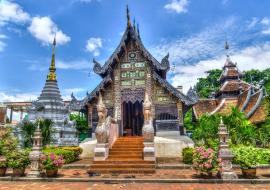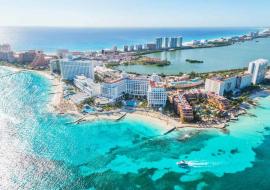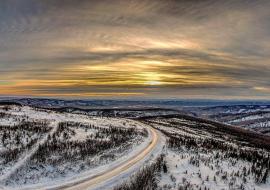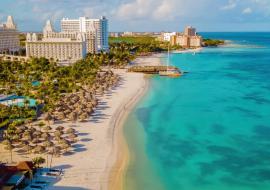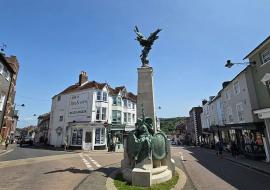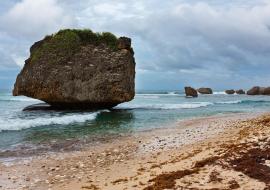A Dozen Must-See Places in the Americas to Visit in 2018
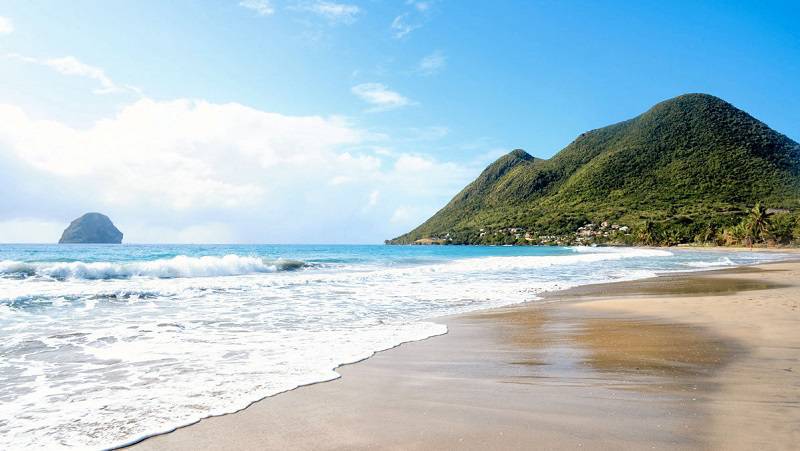
Martinique
The hot news in Martinique is the destination’s newfound ease of access. Norwegian Air operates nonstop flights — as low as $79 one way — to its capital, Fort-de-France. Visitors to Martinique will not only encounter an island with a French feel — it is, after all, an overseas French territory — but also a distinctly West Indian vibe (Creole is spoken widely across the island). Traditions as disparate as Colombo-seasoned cuisine, storytelling festivals, Carnival celebrations and annual boat races live side by side on this fascinating island.
While it lacks the grand boulevards and architectural splendor of Paris, the historic capital of Fort-de-France features several impressive structures, from Fort St. Louis to the Schoelcher Library, which honors French abolitionist writer Victor Schoelcher.
For an off-the-beaten-path excursion, head to La Savane des Esclaves in the resort town of Trois Ilets. The open-air museum honors Martinique’s African and Caribbean legacies with a post-slavery native village and working farm featuring traditional construction techniques and agricultural processes. Unlike some Caribbean plantation attractions that gloss over ugly histories, La Savane’s exhibits include frank displays and artifacts depicting incredible cruelty and violence of colonial slavery — a part of the island’s history that any beach-going visitor should take in.
Santa Fe, New Mexico
Santa Fe is experiencing a rapid-fire culture shift from a semi-sleepy art town to a progressive creative hotspot without rival. With the explosive popularity of Meow Wolf, the George R.R. Martin-funded immersive art experience, the opening of contemporary art space Site and the creative works in the galleries on Canyon Road, there’s been a complete reimagining of art in the New Mexican city.
One of the most radical changes visitors will notice in 2018 is the reclamation of authenticity among Native American art and goods. Local artists are fighting against the fakes industry that takes work away from Native communities. Native art is also celebrated at La Posada, a luxury adobo hotel that’s supposedly haunted. And don’t leave without trying the city’s famed green chili — particularly in the form of green chili clam chowder at La Choza.
Buenos Aires
In Argentina, you can eat some of the best food in the world at some of the lowest prices imaginable. Sure, that requires a long flight, but take a red-eye and you’ll arrive to incredible grass-fed steak, at the low price of around 300 Argentinian pesos, or around $17, at old-school parillas like Don Julio and modern steakhouses like La Carniceria. At Tegui, one of the best fine-dining restaurants in the city, a five-course menu will run you $40.
The deals don’t end with the food. You’ll find remarkable Malbecs at a fraction of the price they’d be served in the United States. The free walking tours are top-notch and include a guided visit to La Recoleta, the gorgeous cemetery where the tombs — including Eva Peron’s — are works of art.
Buenos Aires is such a steal that Booking.com named it one of the most affordable places to travel in 2018 — and to get the most out of it, travel in January or February, when the prices are the lowest of the year.
Minneapolis
This cold, northern city, which has seen rapid growth and will host the Super Bowl in February, is also teeming with exciting food news. In the Twin Cities of Minneapolis and St. Paul, diners can try the seasonal menus at Spoon and Stable, Bachelor Farmer, Alma and Piccolo. Across the river in St. Paul, Heirloom offers elevated farmhouse cuisine — think cauliflower soup, roast chicken, carrot pasta with goat butter — in a charming room covered in reclaimed wood. Beer nerds will find hop heaven at Surly Brewing, a beer hall in the center of the city, plus there’s a crop of new breweries popping up, including Cosmos Brewing, Headflyer Brewing, Pryes Brewing and BlackStack Brewing.
Minneapolis’ boutique hotels are catching up to the cool culinary scene as well — choose between the Nordic-inspired Hewing Hotel, which opened in 2016 in a refurbished warehouse in the North Loop, or the new Graduate Minneapolis, located right on the University of Minnesota’s campus.
Asheville, North Carolina
Asheville’s laidback vibe and approachable size make it the ideal location for a short getaway. Visitors can take in the Blue Ridge Mountains on a hike and bag peaks like Grandfather Mountain, where Native Americans used to perform rituals. If you’d prefer pampering to huffing and puffing, head to the Biltmore, which was George Vanderbilt’s 8,000-acre estate with sprawling landscapes and castle-like mansions.
Once you’ve worked up an appetite, focus your attention on Appalachian food, a traditional cuisine that involves Southern-style cooking but is all about foraged ingredients from the mountains. The No Taste Like Home tour shows guests how to roam the mountains for edible bounty. The tour pairs guests with well-known local restaurants (like The Market Place, Cúrate and Nightbell) to transform the foraged ingredients into appetizers.
Asheville could be America’s new beer capital, with more breweries per capita than any other U.S. city. It has several funky and downright weird beer festivals throughout the year.
“It’s not just the number of breweries, it’s the diversity of their offerings: sours and wild beers from Hi-Wire, saisons and farmhouse ales from Burial, English Bitter and British-style Porter from Green Man, sessionable blonde ale and IPA from UpCountry and much, much more,” Ben Keene, editorial director of BeerAdvocate, said in an email. Keene recommends visiting the breweries as well: Sierra Nevada’s impressive “Malt Disney World,” Highland Brewing’s spacious rooftop beer garden and One World Brewing’s tiny yet cozy taproom. Cheers to your best vacation yet.
Montreal
If you’re not one of the people who actually moved to Canada after Trump was elected, this arts- and culture-driven city right over the border is must for beer lovers, or anyone seeking a getaway that feels like Europe for a fraction of the price. Québec’s European-influenced beer culture means they’ve long perfected the beer styles that are trendy now in the United States — barrel-aged farmhouse ales, puckering sours and smoked saisons are the norm at places like Station Ho.St, the Montréal bar outpost from Hopfenstark, where metal heads and hipster geeks will feel equally at home.
Montréal’s Little Italy is the unexpected neighborhood meeting every beer nerd’s needs. Vices and Versa is a well-respected pub serving a robust list of mircobrews in a relaxed hangout; around the corner, La Bièrothèque beer shop offers an excellent bottle and can selection from local, independent breweries, or microbrasseries (it’s also next door to a famous donut shop, Trou De Beigne); and for a brilliantly lit, Millennial pink-bathed brunch, Brasserie Harricana serves thoughtful dishes, like sturgeon croquettes or fattoush salad, paired with beers and other beverages made on-site, like hop soda and kombucha.
San Diego
“San Diego blends a small town and big-city feel all in one,” Archana Ram, a New York transplant and senior editor at San Diego Magazine, said in an interview. “It’s much more cool and modern and cutting edge than people give it credit for.” Ram describes San Diego as a “city of villages,” each with its own feel.
Much of the recent restaurant buzz is centered on Little Italy, where Top Chef alums Richard Blais and Brian Malarkey have launched their own mini restaurant empires: Blais with Juniper and Ivy and the fast-casual (and rapidly expanding) fried-chicken joint Crack Shack; Malarkey with Herb & Wood and its new sibling, Herb & Eatery. There’s much more than pizza and pasta going on in this booming district: other diverse debuts include the ultra-glam, three-years-in-the-making steakhouse Born & Raised, the soon-to-open izakaya Cloak & Petal, the sprawling Roma Urban Market, and tapas joint Bar Bodega. Considering the city’s proximity to the border — Tijuana is a 15-minute drive away — you’ll find some of the country’s best Mexican food in San Diego; much of it is in Barrio Logan, a vibrant Chicano neighborhood with colorful street art, cult coffee roasters like Café Moto and Café Virtuoso, and great restaurants aplenty (Las Cuatro Milpas and Salud! have some of the best tacos north of the border).
And San Diegans leave the wine swilling to Napa and Sonoma — this part of the state is the craft beer capital of America, with more than 150 independent breweries. Ones to keep an eye out for in 2018: Creative Creature and Full Body Brewing.
Grenada
It doesn’t take long for visitors to Grenada to understand why this southern Caribbean gem is widely known as the “Spice Island.” Encompassing a mere 131 square miles, it’s blessed with an abundance of nutmeg, mace and other savory spices that show up in nearly every local dish.
Grenada’s profusion of spices complement natural wonders that range from lush mountain peaks teeming with indigenous flora to plunging waterfalls. Its numerous dive sites include a magical, underwater sculpture park, where the sculptures reflect aspects of Grenadian culture while forming an ideal substrate for marine development.
Typical Grenada accommodations feature small-scale hotels and a handful of upscale resorts, including the Spice Island Beach Resort and the Sandals La Source Grenada Resort & Spa. Silversands, a high-end 43-suite boutique property, will launch in March. It overlooks Grand Anse Beach, easily one of the Caribbean’s finest.
For an under-the-radar experience, visit Grenada’s sister island of Carriacou (90 minutes from Grenada by ferry; 20 minutes by air). It’s an ideal day trip for top-shelf diving and snorkeling from deserted, calm-water beaches and pristine coral reefs. Best of all, Grenada couldn’t be easier to access — it’s just a short flight from hubs like New York, Miami, Atlanta and Toronto.
Houston
After surviving the wreckage of Hurricane Harvey and pulling off a historic World Series win, Houston is primed to start 2018 with a renewed sense of confidence, determination and swag. Old neighborhoods are being reimagined as niche creative communities and an expanded light rail system has made downtown more conducive to brunching and bar hopping.
In February and March, people will descend upon the city for the annual Houston Livestock Show and Rodeo, with its frenzied calf scrambles, concerts and barbecue contests. Tex-Mex is at its finest at December’s annual Tamale Festival, and those who happen to be visiting in June can stop by Emancipation Park for the city’s yearly Juneteenth celebration.
No trip is complete without visiting the John T. Biggers art collection at the University Museum at Texas Southern University, a historically black college located in Houston’s historic Third Ward. Once a hub for soul food kitchens like Alfreda’s Cafeteria and nameless neighborhood fish spots, the area now includes flavorful vegan spots like Doshi House and Sunshine’s Vegetarian Deli. Third Ward is also home to Frenchy’s Chicken, which Beyoncé has name-checked in her music and visited when she was in town for Hurricane Harvey relief. But visitors will have to act fast if they want to eat at the flagship location — it’s slated for relocation in the spring.
Mexico City
Despite the devastating earthquake in September, travelers shouldn’t be deterred from visiting this dynamic destination. Not only is Mexico City the 2018 World Design Capital — the first destination in North America to earn the honor — but it’s also an easy getaway, with nonstop flights from most major U.S. cities. And though the peso is stronger now than it was in early 2017, you’ll still find great value — especially when it comes to the delicious food. (Tacos go for mere cents; don’t miss the ones filled with chicharrón from the Meche y Rafael butcher stand at Mercado de Medellín.)
While many buildings in the popular tourist area of Condesa saw structural damage, recent tourists say signs of it there are hard to see. “The quake sparked a genuine solidarity and generosity here, and people pitched in to quickly clear the streets of rubble and debris,” said Rafael Micha of Grupo Habita, which owns four hotels in the city, including Condesa DF, a well-located, stylish base. And other areas, like Polanco, home to high-end boutiques, chef Enrique Olvera’s new-and-improved Pujol, the Museo Soumaya and Museo Jumex, were relatively unscathed.
There are plenty of popular sights worth joining other tourists for: the zócalo and Palacio de Bellas Artes in central district; the expansive, lush and museum-filled Bosque de Chapultepec; and Museo Frida Kahlo among them. But for something totally different, grab an Uber about 10 miles south to the campus of the National Autonomous University of Mexico, which also happens to be a UNESCO World Heritage site. (Just don’t go during rush hour, when traffic is notoriously awful.) Here, you’ll find a large-scale mosaic by Mexican architect and artist Juan O’Gorman, the Universum science center and a peaceful nature reserve and botanical garden. Consider it the ideal place to walk off all the tacos you’ve been eating.
Stowe, Vermont
Stowe is much more than a desirable ski spot: Biking, hiking, snowshoeing, horseback riding, ice climbing, dog sledding, kayaking, swimming (under waterfalls, if you want) — it’s all possible in the charming northern town that’s surrounded by both dense forest and mountainous peaks. In snowy season, stay at Stowe Mountain Lodge, where you can sleep in one of the new 3,000-square foot ski-in ski-out residences — it makes being one of the first to hit that fresh powder at Spruce Peak at Stowe Mountain a whole lot more likely.
In warmer months, challenge your legs to a journey up Mount Mansfield, Vermont’s highest mountain, which peaks at 4,395 feet above sea level. Smuggler’s Notch State Park is another worthy attraction open from mid-May to mid-October, ripe with scenic hikes, pet-friendly walks and plenty of mountain biking trails. Inside the park, after a sweaty hike, you might take a dip in a swimming hole like Rum Runners’ Hideaway, a mountainside reservoir equipped with an aqua jump trampoline, or Bootleggers’ Basin, with a bounty of water sport opportunities, including a chance to soar in the air with the futuristic Fly Board.
Source: Mic







